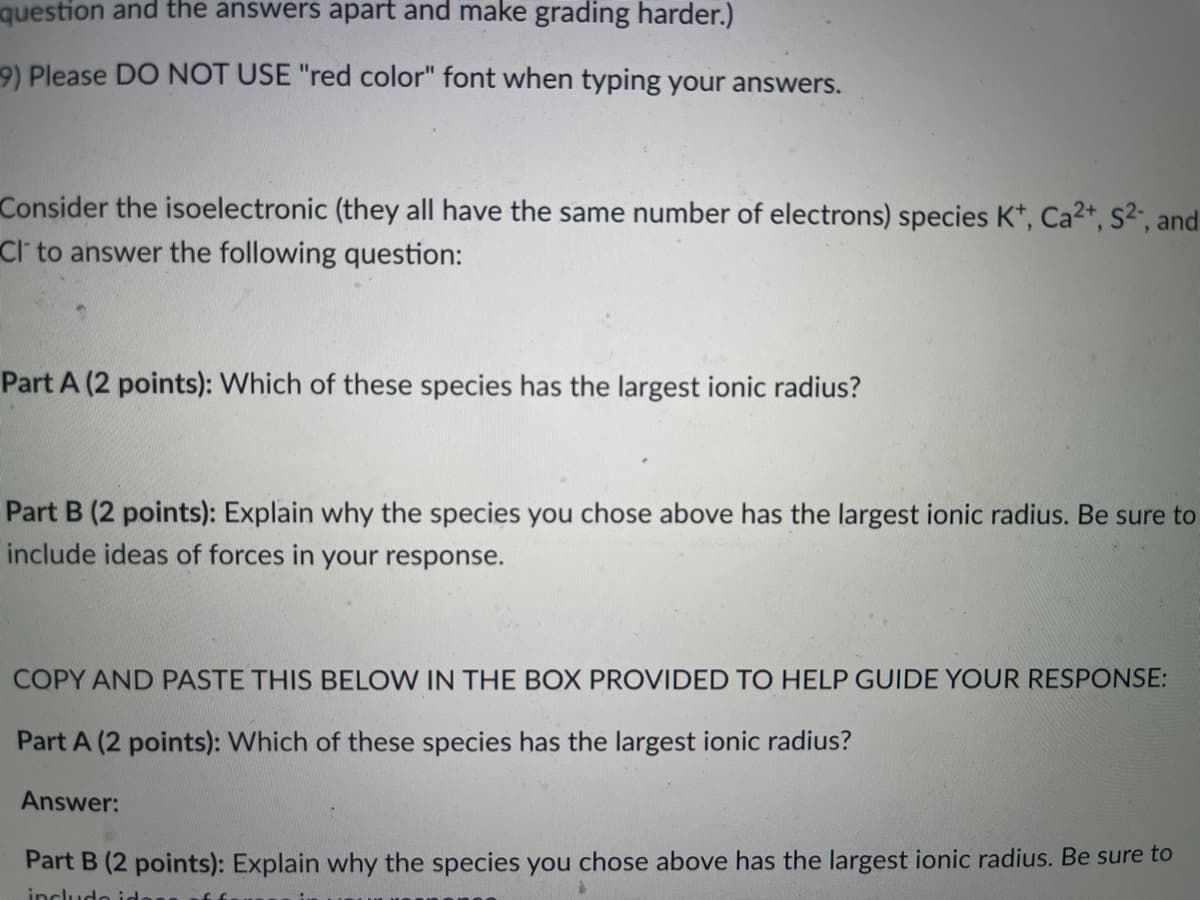Part A (2 points): Which of these species has the largest ionic radius? Part B (2 points): Explain why the species you chose above has the largest ionic radius. Be sure to include ideas of forces in your response. COPY AND PASTE THIS BELOW IN THE BOX PROVIDED TO HELP GUIDE YOUR RESPONSE: Part A (2 points): Which of these species has the largest ionic radius? Answer: Part B (2 points): Explain why the species you chose above has the largest ionic radius. Be sure to includo id
Part A (2 points): Which of these species has the largest ionic radius? Part B (2 points): Explain why the species you chose above has the largest ionic radius. Be sure to include ideas of forces in your response. COPY AND PASTE THIS BELOW IN THE BOX PROVIDED TO HELP GUIDE YOUR RESPONSE: Part A (2 points): Which of these species has the largest ionic radius? Answer: Part B (2 points): Explain why the species you chose above has the largest ionic radius. Be sure to includo id
Chemistry & Chemical Reactivity
9th Edition
ISBN:9781133949640
Author:John C. Kotz, Paul M. Treichel, John Townsend, David Treichel
Publisher:John C. Kotz, Paul M. Treichel, John Townsend, David Treichel
Chapter7: The Structure Of Atoms And Periodic Trends
Section: Chapter Questions
Problem 37GQ: These questions are not designated as to type or location in the chapter. They may combine several...
Related questions
Question

Transcribed Image Text:question and the answers apart and make grading harder.)
9) Please DO NOT USE "red color" font when typing your answers.
Consider the isoelectronic (they all have the same number of electrons) species K*, Ca2+, S², and
Cl' to answer the following question:
Part A (2 points): Which of these species has the largest ionic radius?
Part B (2 points): Explain why the species you chose above has the largest ionic radius. Be sure to
include ideas of forces in your response.
COPY AND PASTE THIS BELOW IN THE BOX PROVIDED TO HELP GUIDE YOUR RESPONSE:
Part A (2 points): Which of these species has the largest ionic radius?
Answer:
Part B (2 points): Explain why the species you chose above has the largest ionic radius. Be sure to
includo ide
Expert Solution
This question has been solved!
Explore an expertly crafted, step-by-step solution for a thorough understanding of key concepts.
Step by step
Solved in 3 steps with 3 images

Knowledge Booster
Learn more about
Need a deep-dive on the concept behind this application? Look no further. Learn more about this topic, chemistry and related others by exploring similar questions and additional content below.Recommended textbooks for you

Chemistry & Chemical Reactivity
Chemistry
ISBN:
9781133949640
Author:
John C. Kotz, Paul M. Treichel, John Townsend, David Treichel
Publisher:
Cengage Learning

Chemistry & Chemical Reactivity
Chemistry
ISBN:
9781337399074
Author:
John C. Kotz, Paul M. Treichel, John Townsend, David Treichel
Publisher:
Cengage Learning

Chemistry: Matter and Change
Chemistry
ISBN:
9780078746376
Author:
Dinah Zike, Laurel Dingrando, Nicholas Hainen, Cheryl Wistrom
Publisher:
Glencoe/McGraw-Hill School Pub Co

Chemistry & Chemical Reactivity
Chemistry
ISBN:
9781133949640
Author:
John C. Kotz, Paul M. Treichel, John Townsend, David Treichel
Publisher:
Cengage Learning

Chemistry & Chemical Reactivity
Chemistry
ISBN:
9781337399074
Author:
John C. Kotz, Paul M. Treichel, John Townsend, David Treichel
Publisher:
Cengage Learning

Chemistry: Matter and Change
Chemistry
ISBN:
9780078746376
Author:
Dinah Zike, Laurel Dingrando, Nicholas Hainen, Cheryl Wistrom
Publisher:
Glencoe/McGraw-Hill School Pub Co

World of Chemistry, 3rd edition
Chemistry
ISBN:
9781133109655
Author:
Steven S. Zumdahl, Susan L. Zumdahl, Donald J. DeCoste
Publisher:
Brooks / Cole / Cengage Learning

Introductory Chemistry: A Foundation
Chemistry
ISBN:
9781337399425
Author:
Steven S. Zumdahl, Donald J. DeCoste
Publisher:
Cengage Learning

Chemistry: The Molecular Science
Chemistry
ISBN:
9781285199047
Author:
John W. Moore, Conrad L. Stanitski
Publisher:
Cengage Learning